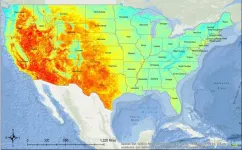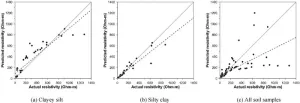(Press-News.org) Neanderthal remains recently discovered in a cave in France support well-known theory of why the Neanderthals became extinct, researchers behind a new study say.
In recent years, researchers have offered different explanations for why modern humans survived and the Neanderthals became extinct some 40,000 years ago.
A new study from the Globe Institute at the University of Copenhagen supports one of the main hypotheses. The researchers behind the new study discovered Neanderthal remains of a male in a cave in southern France, and the discovery supports the hypothesis that the Neanderthals may have gone extinct because of their antisocial lifestyle.
“When we look at these genomes from Neanderthals, we see that they are quite inbred and therefore don’t have much genetic diversity. They have been living in small groups for many generations. We know that inbreeding reduces genetic diversity in a population, which can be detrimental to their ability to survive if it occurs over a longer term,” one of the researchers behind the new study, Associate Professor Martin Sikora from the Globe Institute, explains and adds:
“The newly found Neanderthal genome is from a different lineage than the other late Neanderthals previously studied. This supports the notion that social organization of Neanderthals was different to early modern humans who seemed to have been more connected.”
In other words, compared to the Neanderthals, early modern humans were more likely to connect with other groups, which is an advantage if you want to survive.
“This is in the more speculative end, but even just the notion of being able to communicate more and exchange knowledge is something humans do that Neanderthals to some extend might not have done, due to their isolated lifestyles by organizing themselves in smaller groups. And that is an important skill to have. We see evidence of early modern humans in Siberia forming so-called mating networks to avoid issues with inbreeding, while living in small communities, which is something we haven’t seen with Neanderthals,” Postdoc Tharsika Vimala says.
DNA sheds light on the history of the Neanderthals
Researchers have found little Neanderthal DNA considering the substantial number of discovered Neanderthal remains across Eurasia. Some of the oldest Neanderthal DNA dates back to 120 thousand years ago and have been recovered from Neanderthals found in the Denisova Cave (Altai Mountains) and caves in Scladina (Belgium) and Hohlenstein-Stadel (Germany). In fact, the “new” Neanderthal genome is merely the fifth of its kind to be found in Western Europe with an age below 50 thousand years old.
“Our team in Copenhagen extracted DNA from his tooth, sequenced the DNA and analysed his nuclear genome, which is the DNA found within the core of the cells. The DNA was analysed along with other known Neanderthal genomes to understand their shared history,” Martin Sikora says.
In addition, the researchers re-analysed the genome of another known late Neanderthal from France and found that this individual also carried ancestry from a distant Neanderthal lineage which is different from the ‘new’ genome. The findings tell us that multiple isolated communities might have been present in Western Europe up until their demise.
According to the researchers, the hypothesis is not new and has previously been found for Neanderthals living in the Altai Mountains which is naturally a more isolated area. Up until now they did not have the genomic evidence to confirm it for the Western European Neanderthals. The new discovery is therefore an important piece in the puzzle of Neanderthal history.
“It is something that we have talked about for a while. But we needed more evidence, and this is some of the evidence that we were looking for and needed to figure out how likely this hypothesis of them going extinct because of their isolated lifestyle is. We do, however, need much more genomic data to paint a better picture of their history,” says Tharsika Vimala.
The study has been published in Cell Genomics.
END
The Neanderthals may have become extinct because of their isolated lifestyle
2024-09-11
ELSE PRESS RELEASES FROM THIS DATE:
Microorganisms can travel long distances in the troposphere
2024-09-11
Analysis of air samples taken at altitudes of up to 3,000 metres above Japan has revealed the presence of a vast range of viable bacteria and fungi transported by air masses originating more than 2,000 kilometres away, in regions enriched with fertilisers and pesticides. The study, published in Proceedings of the National Academy of Sciences (PNAS), reveals a new way in which human, animal and plant pathogens may travel to distant geographical regions. This research has been led by the Barcelona Institute for Global Health (ISGlobal), a centre supported by “la Caixa” Foundation, in collaboration with the Daniel ...
Ropirio launches from Wyss Institute to develop first-in-class lymphatic medicines
2024-09-11
The Wyss Institute at Harvard University announced today that Ropirio Therapeutics, Inc. (Ropirio) has secured a worldwide, exclusive license from Harvard’s Office of Technology Development (OTD) and Boston University (BU)’s Technology Development office for novel molecules that activate the lymphatic system - a first in the pharma industry.
“There has been a tremendous amount of research into the lymphatic system over the last decade, with scientists uncovering new lymphatic vasculature and understanding the critical role it plays across a wide range of serious diseases. Ropirio is building on this explosion of research ...
Oxycodone use in Australia dropped 45% after policy changes to opioid prescribing
2024-09-11
Between 2018 and 2020, Australia implemented policy changes to improve the quality and safety of opioid prescribing, with a specific focus on oxycodone. A new study led by The University of Queensland (UQ) using wastewater analysis has determined that oxycodone consumption in Australia dropped by 45% from 2019 to 2020, coinciding with those national policy changes.
In November 2019, the Australian National Prescribing Service launched a federal initiative to improve opioid prescribing. The initiative involved alerting high-prescribing clinicians that their opioid prescribing practices were outside typical ...
Hot streets, historic bias: effects on neighborhood walking in older adults
2024-09-11
A neighborhood’s walkability is affected by many factors such as street connectivity and density; access to destinations and aesthetics; investment in walking and biking infrastructure; and the presence or absence of urban natural features, specifically tree cover.
Not all neighborhoods are alike. Many neighborhoods in impoverished and minority communities lack the cooling effect of vegetation and tree cover, especially in urbanized areas. As a result, residents face the “heat island effect,” where temperatures remain higher in urban areas ...
ETRI establishes international standards for AI safety and reliability support
2024-09-11
Recently, many major countries around the world, starting with the U.S., Japan, Germany, China, U.K., etc., have issued an administrative order to ensure the safety of AI technology, putting an emphasis on the safe, effective implementation of AI into their systems. In line with such trends, Korean researchers have collaborated with renowned AI experts from all around the world to create new AI-related international standards, garnering attention from the global AI community.
Proposal No.
Title
Status
ISO/IEC ...
Atypical metabolite levels at birth may increase SIDS risk
2024-09-11
WHAT:
Newborns who had an atypical pattern of metabolites were more than 14 times as likely to die of sudden infant death syndrome (SIDS), compared to infants who had more typical metabolic patterns, according to a study funded in part by the National Institutes of Health. Metabolites are molecules produced by the body’s various chemical reactions. Researchers found that infants who died of SIDS had a specific pattern of metabolites compared to infants who lived to their first year. The researchers believe that checking for this pattern could provide ...
How toxic are they? Researchers investigate the environmental consequences of new biotechnological pesticides
2024-09-11
Biotechnological pesticides are a promising alternative to traditional chemical pesticides. But we have limited knowledge of how toxic they are to other organisms in the environment beyond regulatory assessments. A new research centre will now work to provide this knowledge – especially to ensure the EU has a chance of joining the growing market for biotechnological pesticides. As for now, Europe has failed to keep up.
"If a thing kills something, we need to know how it kills, and who and what else it may kill," says Professor Nina Cedergreen of the University of Copenhagen’s Department of Plant and Environmental Sciences.
She is ...
Advancing power grounding systems: A novel predictive model for soil resistivity
2024-09-11
Proper power grounding systems are necessary for maintaining the safety and reliability of critical electrical subsystem infrastructure, such as substations. Power grounding systems provide a low-resistance path for electrical fault currents to flow into the earth, preventing electrical shocks, fires, and damage to vital equipment. Investigation of soil resistivity is crucial for designing power grounding systems. For the most cost-effective and efficient grounding systems for electrical substations, it is imperative to carefully ...
Unique nanodisk pushing photonic research forward
2024-09-11
Researchers at Chalmers University of Technology, in Sweden, have for the first time succeeded in combining two major research fields in photonics by creating a nanoobject with unique optical qualities. Since the object is a thousand times thinner than the human hair, yet very powerful, the breakthrough has great potential in the development of efficient and compact nonlinear optical devices. “My feeling is that this discovery has a great potential,” says Professor Timur Shegai, who led the study at Chalmers.
Photonic applications harness the power of light-matter interactions to generate ...
Century-old experiment secures beer and whiskey’s future
2024-09-11
Thanks to an experiment started before the Great Depression, researchers have pinpointed the genes behind the remarkable adaptability of barley, a key ingredient in beer and whiskey. These insights could ensure the crop’s continued survival amidst rapid climate change.
Grown everywhere from Asia and Egypt to Norway and the Andes mountains of South America, barley is one of the world’s most important cereal crops and has been for at least 12,000 years. As it has spread across the globe, random ...




